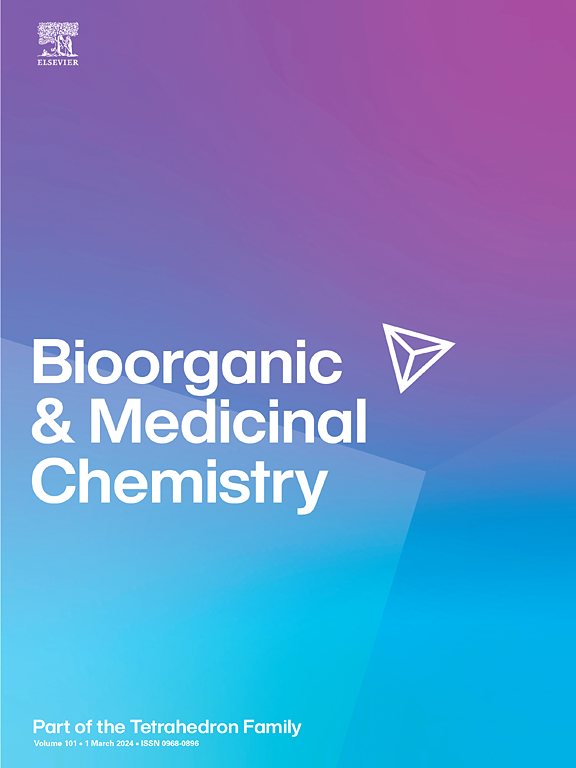Exploring anticancer properties of new triazole-linked benzenesulfonamide derivatives against colorectal carcinoma: Synthesis, cytotoxicity, and in silico insights
IF 3.3
3区 医学
Q2 BIOCHEMISTRY & MOLECULAR BIOLOGY
引用次数: 0
Abstract
This study reports the design, synthesis, and characterization of a novel series of benzene sulfonamide-triazole hybrid derivatives, to evaluate their anticancer potential against colorectal cancer. The synthesized compounds were characterized using NMR and HRMS spectroscopic techniques. In vitro cytotoxicity assessments revealed that compounds 5g and 5j exhibited significant anticancer effects. 5g showed the highest potency in the DLD-1 cell line (IC50 = 11.84 µM), while 5j demonstrated robust activity in the HT-29 cell line (IC50 = 9.35 µM). Apoptotic analysis indicated that compound 5g effectively induced early and total apoptosis, surpassing the chemotherapeutic agent 5-fluorouracil (5-FU), highlighting its therapeutic potential. Molecular docking studies showed strong binding interactions with key proteins involved in colorectal cancer progression, such as TGFβ2 and VEGFR1. 5j displayed a high binding affinity for TGFβ2 (MM-GBSA ΔG = −92.52 kcal/mol) and 5g showed promising interactions with VEGFR1 (ΔG = −70.63 kcal/mol). Molecular dynamics simulations confirmed the stability of the ligand–protein complexes, indicating potential as targeted therapeutic agents. Compounds 5g and 5j demonstrate significant promise for further development in colorectal cancer treatment.

探索新的三唑连接苯磺酰胺衍生物对结直肠癌的抗癌特性:合成、细胞毒性和硅观察。
本研究报道了一系列新的苯磺酰胺-三唑杂化衍生物的设计、合成和表征,以评估其对结直肠癌的抗癌潜力。利用核磁共振和HRMS光谱技术对合成的化合物进行了表征。体外细胞毒性评价表明,化合物5g和5j具有显著的抗癌作用。5g对DLD-1细胞株的IC50为11.84µM, 5j对HT-29细胞株的IC50为9.35µM。凋亡分析表明,化合物5g可有效诱导早期和全细胞凋亡,超过化疗药物5-氟尿嘧啶(5-FU),显示其治疗潜力。分子对接研究显示,与参与结直肠癌进展的关键蛋白,如tgf - β2和VEGFR1有很强的结合相互作用。5j与tgf - β2表现出高结合亲和力(MM-GBSA ΔG = -92.52 kcal/mol), 5g与VEGFR1表现出良好的相互作用(ΔG = -70.63 kcal/mol)。分子动力学模拟证实了配体-蛋白复合物的稳定性,表明其作为靶向治疗剂的潜力。化合物5g和5j显示出在结直肠癌治疗中进一步发展的重大前景。
本文章由计算机程序翻译,如有差异,请以英文原文为准。
求助全文
约1分钟内获得全文
求助全文
来源期刊

Bioorganic & Medicinal Chemistry
医学-生化与分子生物学
CiteScore
6.80
自引率
2.90%
发文量
413
审稿时长
17 days
期刊介绍:
Bioorganic & Medicinal Chemistry provides an international forum for the publication of full original research papers and critical reviews on molecular interactions in key biological targets such as receptors, channels, enzymes, nucleotides, lipids and saccharides.
The aim of the journal is to promote a better understanding at the molecular level of life processes, and living organisms, as well as the interaction of these with chemical agents. A special feature will be that colour illustrations will be reproduced at no charge to the author, provided that the Editor agrees that colour is essential to the information content of the illustration in question.
 求助内容:
求助内容: 应助结果提醒方式:
应助结果提醒方式:


